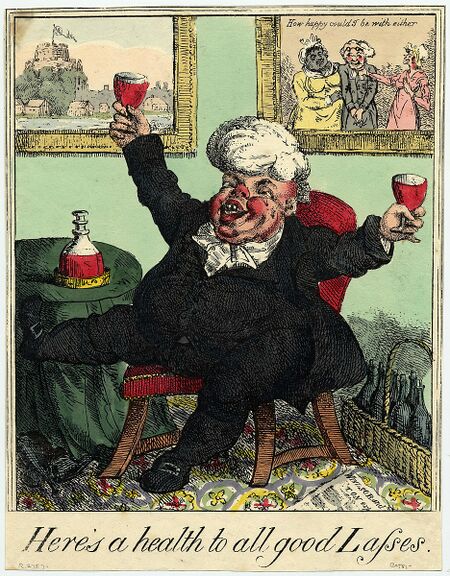Annotation:Here's a health to all good lasses: Difference between revisions
Appearance
No edit summary |
No edit summary |
||
| Line 2: | Line 2: | ||
{{TuneAnnotation | {{TuneAnnotation | ||
|f_tune_annotation_title= https://tunearch.org/wiki/Annotation:Here's_a_health_to_all_good_lasses > | |f_tune_annotation_title= https://tunearch.org/wiki/Annotation:Here's_a_health_to_all_good_lasses > | ||
|f_annotation=[[File:Lasseshealth.jpg|right|450px|thumb|George Cruikshank (?), 1818.]]'''HERE'S A HEALTH TO ALL GOOD LASSES.''' English, Air (2/4 time). D Major. Standard tuning (fiddle). One part. A much-anthologized song [Roud 1235], printed in Edward Jones's '''Musical Bouquet, or popular songs and ballads''' (London, 1799, p. 34), '''London Minstrel''' (1820), '''Universal Songster and Museum of Mirth''' (1825) and similar songsters and chapbooks from the end of the 18th century through the 19th. A glee (a song in parts for men), it was derived from a part-song by Pietro Guglielmi (1728–1804). A favorite of London “Song & Supper” clubs, it found its way into rural tradition in Oxfordshire | |f_annotation=[[File:Lasseshealth.jpg|right|450px|thumb|George Cruikshank (?), 1818.]]'''HERE'S A HEALTH TO ALL GOOD LASSES.''' English, Air (2/4 time). D Major. Standard tuning (fiddle). One part. A much-anthologized song [Roud 1235], printed in Edward Jones's '''Musical Bouquet, or popular songs and ballads''' (London, 1799, p. 34), '''London Minstrel''' (1820), '''Universal Songster and Museum of Mirth''' (1825) and similar songsters and chapbooks from the end of the 18th century through the 19th. A glee (a song in parts for men), it was derived from a part-song by Pietro Guglielmi (1728–1804). A favorite of London “Song & Supper” clubs, it found its way into rural tradition in Cumberland, Oxfordshire, Dorset, the Isle of Mann and numerous other places. | ||
|f_source_for_notated_version= | |f_source_for_notated_version= | ||
|f_printed_sources=Edward Riley ('''Riley’s Flute Melodies vol. 1'''), New York, 1814; No. 200, p. 52. | |f_printed_sources=Edward Riley ('''Riley’s Flute Melodies vol. 1'''), New York, 1814; No. 200, p. 52. | ||
Revision as of 14:43, 22 February 2024
X:1 T:Here’s a health to all good lasses M:2/4 L:1/8 B:Edward Riley – “Riley’s Flute Melodies vol. 1” (New York, 1814, No. 200, p. 52) B: https://archive.org/details/flutemelodies0000rile/page/n55/mode/2up Z:AK/Fiddler’s Companion K:D d>e|gdgf|ed f>g|afba|gfaa|aaba|aggg|ggag |gf a>a| bbac|d2 a>a|bbac|d2 de|fdec|ddde|fdec|d2 b>b| afge |d2 ab|ge A/B/c/A/|dd ab|ge A/B/c/A/|dd aa| aaba|aggg|ggag|gf a>a|bbac|d2 a>a|bbac|d2||


